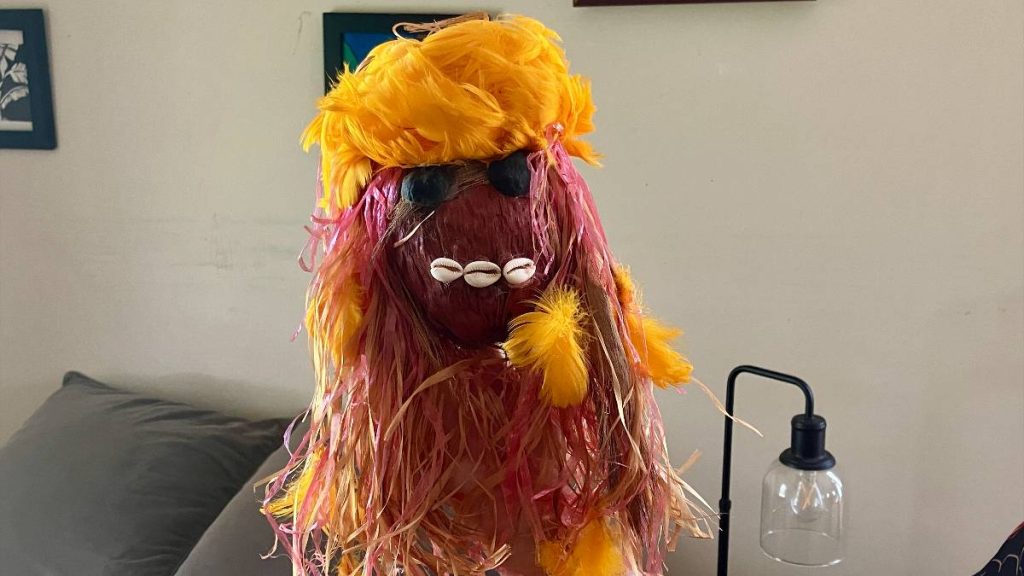Once a critically threatened cultural practice, Hawaiian hula puppetry making a comeback
The hula dancer’s arms uplift to the beating of bamboo pipes, in tandem with a lei-crowned head and a body draped in patterned cloth. But the performer is not a person. It’s a puppet.
While hula is emblematic of Hawai‘i, it is less known that puppetry is a tradition within the world-famous form of dance.
Chucky Boy Chock, executive director of the Kaua‘i Museum in Līhu‘e, said if he asks people to raise their hand if they know anything about hula ki‘i, in a group of 20 “you might see one or two.”

Chock was standing in a recently opened gallery dedicated to hula on Kaua‘i. The first written account of hula ki‘i, or dance of the sacred image, was recorded on the Garden Isle in 1820.
Hula ki‘i once was considered to be a critically endangered cultural practice by those now at the forefront of its revival.
“We began going into our Indigenous communities, where the hula academies were, where the traditional cultural practitioner academies were,” said Auli‘i Mitchell, a kumu hula (hula teacher) based in Puna on Hawai‘i Island.
“Now we’re going into the public: We have a current exhibition at the Capitol Modern and a little bit about it at the Kaua‘i Museum,” Mitchell continued. “That tells me the word’s getting out.”
Mitchell said he grew up knowing nothing other than hula. He was educated by his grandfather, Charles Kahiwahiwa Cash, and his mother, Harriet Aana Cash Mitchell, becoming a kumu hula at the age of 12.
Cash Mitchell in the early 1980s urged her son to study hula ki‘i, using related songs passed down through his family. He encountered his first hula ki‘i puppets during a subsequent visit to the Bishop Museum in Honolulu.
Mitchell described the moment as a transportive experience that compelled him to do more research. Since then, he has disseminated hula ki‘i through performances, exhibitions and workshops in which participants create puppets over the course of a nine-month “birthing process.”
In the first quarter of the 19th century, hula ki‘i was forced underground when the influence of Christian missionaries led to the burning of traditional Hawaiian images and many decades of cultural suppression.
But the practice was kept alive through oral transmission. And in the present, scholarship has documented several distinct kinds of hula ki‘i, including dances, plays and performances conducted with or without a screen shielding the puppeteers.
In some cases, human performers may dance alongside their puppet counterparts, while in others, hula dancers may evoke ki‘i, or images, with their own bodies through stiff postures. Records show this last form was an established practice on the bank of the Wailua River on the East Side of Kaua‘i.
Mitchell performs hula ki‘i on his knees, manipulating wooden puppets carved using a mallet and chisel. Such ki‘i may range dramatically in size, at times reaching 8 feet in height, and may depict an array of forms, including deities, demigods and ancestors.
“They take on all that Hawai‘i is in its connection to creation, to nature, to society, to our famous stories,” Mitchell said. “From the deities down to the kanaka maoli, to our common people.”
Mau Oli Cook, a hula practitioner on Kaua‘i, was introduced to hula ki‘i through kumu hula Nona Beamer, a revered educator, author and proponent of hula who lived from 1923 to 2008.
Beamer, according to Cook, believed the iteration of hula ki‘i she practiced stemmed from her grandmother, renowned composer Helen Desha Beamer, “because it was loving and sweet and kind and fun.”
Unlike the ki‘i carved by Mitchell, Cook’s puppets – modeled on her mentor’s – feature heads made of small coconuts manipulated by fingers inserted into drilled holes. To create their bodies, Cook inserts her forearm into puppet-sized dresses; her extended thumb and pinky finger serve as hands.

Cook has taught the art of hula ki‘i to schoolchildren and adults in Hawai‘i and the U.S. mainland. While her puppets vary in appearance – some possess painted faces, while others have features represented by seashells – all are made in a fashion approved by Beamer.
Cook deems Beamer, who spent four decades teaching at Kamehameha Schools, “an educator par excellence.” She hopes to perpetuate that legacy, stating she has a kuleana (responsibility) to Auntie Nona.
“She is my guiding light, because she was my kumu,” Cook said. “These little kids in Anahola, who are Hawaiian … If it makes them more whole to have that given back to them, then that is what I’m supposed to do.”
Other kumu hula practicing today include Kaponoʻai Molitau, Cody Pueo Pata and Kealiʻi Reichel of Maui; Maile Loo of O‘ahu; Māhealani Uchiyama of Berkeley, California; Taupōuri Tangarō and Leilehua Yuen of Hawai‘i Island.
A 30-minute presentation of Beamer, Cook and other practitioners performing hula ki‘i at the Waimea Plantation Cottages on Kaua‘i has been uploaded to YouTube. The Hula Preservation Society has curated a channel dedicated to hula ki‘i performances by Cook, Mitchell and others on Vimeo.
For more information about the Kaua‘i Museum, visit Kauaimuseum.org.
Sponsored Content
Comments














